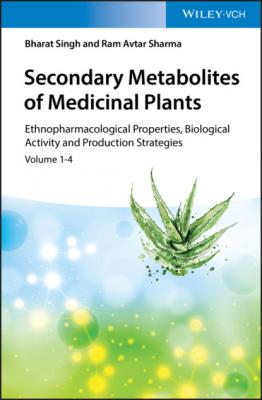Secondary Metabolites of Medicinal Plants. Bharat Singh
Читать онлайн.| Название | Secondary Metabolites of Medicinal Plants |
|---|---|
| Автор произведения | Bharat Singh |
| Жанр | Химия |
| Серия | |
| Издательство | Химия |
| Год выпуска | 0 |
| isbn | 9783527825592 |
2.6.2 Culture Conditions
Plant cell culture is considered as a platform for the synthesis of secondary metabolites in plant cell systems. Significant progress has been made recently in plant cells for enhancing the production of medicinally important natural products (Fischer et al. 2015; Ochoa-Villarreal et al. 2016). A callus induction system for E. adenophorum was developed with leaf, stem, and nodal segment cultured on MS medium with different concentrations of plant growth regulators. These studies provide the prerequisite system for the development of genetic engineering in the future and propagating croftonweed rapidly for further study (Shen et al. 2007).
References
1 Aguilar-Guadarrama, B., Navarro, V., León-Rivera, I., and Rios, M.Y. (2009). Active compounds against tinea pedis dermatophytes from Ageratina pichinchensis var. bustamenta. Nat. Prod. Res. 23: 1559–1565.
2 Barrio, G., Spengler, I., García, T. et al. (2011). Antiviral activity of Ageratina havanensis and major chemical compounds from the most active fraction. Rev. Bras. Farmacogn. 21: 915–920.
3 Bohlmann, F. and Fiedler, L. (1978). Neuenerolidol-derivate a us Ageratina aschenborniana. Phytochemistry 17: 566–577.
4 Davis, T.Z., Lee, S.T., Collett, M.G. et al. (2015). Toxicity of white snakeroot (Ageratina altissima) and chemical extracts of white snakeroot in goats. J. Agric. Food. Chem. 63: 2092–2097.
5 Ding, J.K., Yu, Z., Wang, P. et al. (1991). The odorous constituents and the application of essential oil from Eupatorium adenophorum. Acta Bot. Yunnanica 13: 441–444.
6 Ding, Z.H., Guo, Y.S., and Ding, J.K. (1999). Chemical constituents from the flower of Eupatorium adenophorum. Acta Bot. Yunnanica 21: 505–510.
7 Dong, L.-M., Zhang, M., Xu, Q.-L. et al. (2017). Two new thymol derivatives from the roots of Ageratina adenophora. Molecules 22: 592.
8 Fischer, R., Vasilev, N., Twyman, R.M., and Schillberg, S. (2015). High-value products from plants: the challenges of process optimization. Curr. Opin. Biotechnol. 32: 156–162.
9 García-Sánchez, E., Ramírez-López, C.B., Talavera-Alemán, A. et al. (2014). Absolute configuration of (13R)- and (13S)-labdane diterpenes coexisting in Ageratina jocotepecana. J. Nat. Prod. 77: 1005–1012.
10 Harish Kumar, K., Shanmugavadivu, M., Ranjithkumar, R., and Selvam, K. (2014). Antibacterial activity of leaf extracts of Ageratina adenophora L medicinal plant of Nilgiris Hill, Tamilnadu against human pathogens. Int. J. Biosci. Nanosci. 1: 1–3.
11 Herz, W. (2003). Chemistry of the Oxylobinae. Biochem. Syst. Ecol. 31: 963–993.
12 Kundu, A., Saha, S., Walia, S., and Dutta, T. (2016). Antinemic potentiality of chemical constituents of Eupatorium adenophorum Spreng leaves against Meloidogyne incognita. Nat. Acad. Sci. Lett. 39: 145–149.
13 Lallianrawna, S., Muthukumaran, R., Ralte, V. et al. (2013). Determination of total phenolic content, total flavonoid content and total antioxidant capacity of Ageratina adenophora (Spreng.) King & H. Rob. Sci. Vision 13: 149–156.
14 Lee, S.T., Davis, T.Z., Gardner, D.R. et al. (2010). Tremetone and structurally related compounds in white snakeroot (Ageratina altissima): a plant associated with trembles and milk sickness. J. Agric. Food. Chem. 58: 8560–8565.
15 Lee, S.T., Davis, T.Z., Cook, D., and Stegelmeier, B.L. (2012). Evaluation of drying methods and toxicity of rayless goldenrod (Isocoma pluriflora) and white snakeroot (Ageratina altissima) in goats. J. Agric. Food. Chem. 60: 4849–4853.
16 Li, R.T., Ding, Z.H., and Ding, J.K. (1997). Chemical constituents from Eupatorium adenophorum. Acta Bot. Yunnanica 19: 196–200.
17 Ma, Q.-P., Cheng, C.-R., Li, X.-F. et al. (2015). Chemistry, pharmacological activities and analysis of Ageratina adenophora. Asian J. Chem. 27: 4311–4316.
18 Mohan, D.R. and Ramaswamy, M. (2007). Evaluaton of larvicidal activity of leaf extract of a weed plant, against two important species of mosquitoes, Aedes aegypti and Culex quinquefasciatus. Afr. J. Biotechnol. 6: 631–638.
19 Monroy, O.C.
